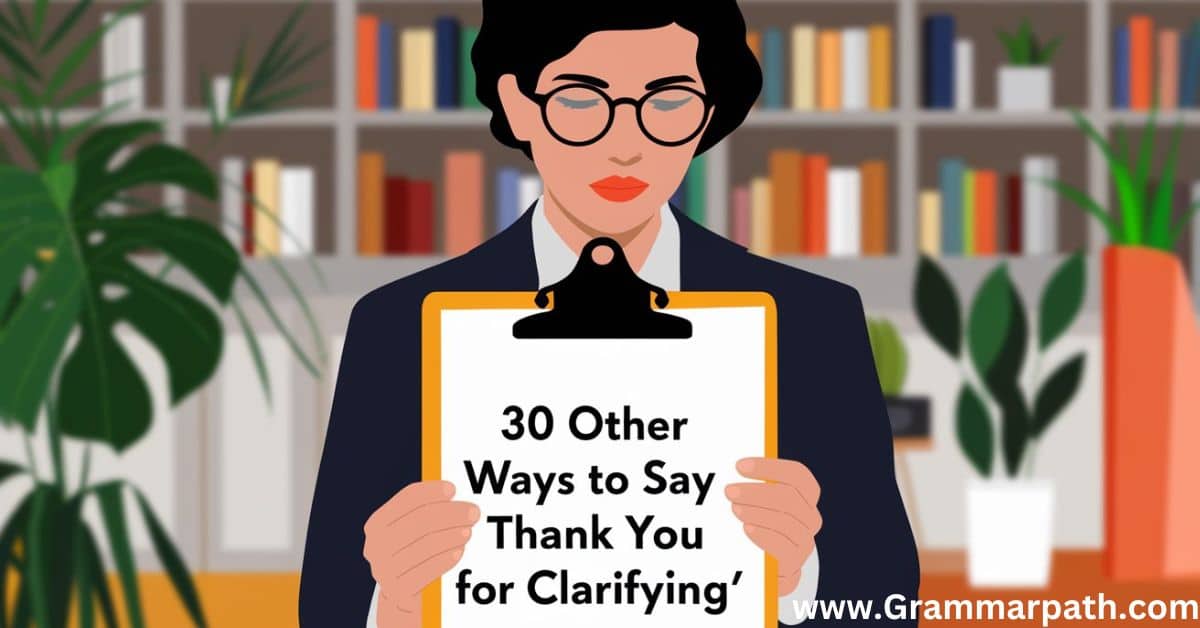
30 Other Ways to Say “Thank You for Clarifying”
Ever found yourself in a linguistic rut, repeating “thank you for clarifying” like a broken record? Let’s face it, we’ve all been there. But what if I told you there’s a whole world of creative expressions waiting to jazz up your gratitude game? Buckle up, language enthusiasts, because we’re about to embark on a journey through the colorful landscape of appreciation.
Imagine you’re at a bustling coffee shop, trying to decipher the difference between a flat white and a latte. The barista patiently explains, and suddenly, the fog lifts. You want to express your thanks, but “thank you for clarifying” feels as stale as day-old espresso. Fear not! This article is your secret weapon, packed with 30 fresh ways to convey your appreciation for crystal-clear explanations.
From boardrooms to classrooms, from formal emails to casual chats, we’ll explore a smorgasbord of phrases that’ll make your gratitude shine brighter than a freshly polished diamond. So, whether you’re a word nerd looking to expand your vocabulary or just someone who wants to sound less like a broken record, you’re in for a treat. Let’s dive in and discover how to turn a simple “thanks” into a masterpiece of appreciation!
is it Professional to Say “Thank you for clarifying”
Saying “Thank you for clarifying” is indeed professional and courteous. It acknowledges the effort someone made to explain something and shows you value clear communication. This simple phrase can strengthen work relationships and encourage further helpful interactions.
However, varying your expressions of gratitude can add warmth and specificity to your thanks, making your appreciation feel more genuine and impactful in professional settings.
What to Say Instead of “Thank you for clarifying”
- “I appreciate your insight.”
- “That really cleared things up for me.”
- “Your explanation was spot-on.”
- “I’m grateful for your patience in explaining that.”
- “You’ve shed light on the matter.”
- “That was an eye-opener. Thanks!”
- “I’m indebted to you for your clear explanation.”
- “You’ve made it crystal clear.”
- “Your clarification was invaluable.”
- “I’m enlightened, thanks to your explanation.”
- “You’ve cleared up my confusion.”
- “Your explanation was a game-changer.”
- “I’m grateful for your elucidation.”
- “You’ve painted a clear picture for me.”
- “Your insights have been illuminating.”
- “I appreciate you breaking that down for me.”
- “Your explanation was spot-on.”
- “Thanks for shedding light on the matter.”
- “I’m grateful for your clear communication.”
- “Your explanation was a breath of fresh air.”
- “You’ve connected the dots for me.”
- “Your explanation was like turning on a light bulb.”
- “I’m impressed by your ability to simplify complex ideas.”
- “Your clarification was like a breath of fresh air.”
- “You’ve untangled that knot for me.”
- “I’m amazed at how you made that so understandable.”
- “Your explanation was worth its weight in gold.”
- “You’ve lifted the fog on this issue.”
- “I’m indebted to you for your crystal-clear explanation.”
- “Your clarification has been a game-changer.”
The Power of Gratitude: Why It Matters
Gratitude isn’t just a polite formality—it’s the secret sauce that transforms ordinary interactions into meaningful connections. When someone takes the time to clarify something for us, they’re not just sharing information; they’re gifting us with understanding. And how we acknowledge that gift can make all the difference.
Think about it: how do you feel when someone responds to your explanation with a heartfelt, creative expression of thanks? It’s like a warm hug for your brain, isn’t it? That’s the power of well-expressed gratitude. It validates the effort, encourages further helpfulness, and strengthens relationships.
But here’s the kicker: the way we express thanks can vary wildly depending on the context. A casual “Cheers for clearing that up, mate!” might work wonders with your buddy, but it might raise eyebrows in a board meeting. That’s why having a diverse arsenal of gratitude expressions is crucial. It’s not just about being thankful—it’s about being thankful in the right way, at the right time.
30 Creative Ways to Express Your Appreciation
Here are 30 Creative Ways to Express Your Appreciation:
1. “I appreciate your insight.”
Scenario: In a team meeting, your colleague Sarah explains a complex project timeline.
Email example:
Subject: Re: Project Timeline Clarification
Dear Sarah,
I appreciate your insight on the project timeline. Your breakdown of each phase has given me a much clearer picture of our roadmap.
Best regards,
Alex

2. “That really cleared things up for me.”
Scenario: A customer service representative explains a billing discrepancy.
Phone conversation: “Oh, I see now. That really cleared things up for me. I’m glad I called—you’ve been incredibly helpful.”
3. “Your explanation was spot-on.”
Scenario: A teacher clarifies a challenging math concept to a student.
In-person conversation: “Wow, Ms. Johnson! Your explanation was spot-on. I finally understand how to solve these equations. Thank you so much!”
4. “I’m grateful for your patience in explaining that.”
Scenario: A tech support agent walks you through a complicated software issue.
Chat support:
You: I'm grateful for your patience in explaining that. It makes so much more sense now!
Agent: You're welcome! I'm glad I could help. Is there anything else you need assistance with?
5. “You’ve shed light on the matter.”
Scenario: A legal advisor clarifies the terms of a contract.
Email example:
Subject: Contract Terms Clarification
Dear Mr. Thompson,
You've shed light on the matter of the non-compete clause. Your detailed explanation has **significantly improved my understanding** of our obligations.
Regards,
Emma Chen
6. “That was an eye-opener. Thanks!”
Scenario: A friend explains a complex political situation.
Text message:
You: That was an eye-opener. Thanks! I had no idea the situation was so nuanced.
Friend: Happy to help! It's a complicated issue for sure.
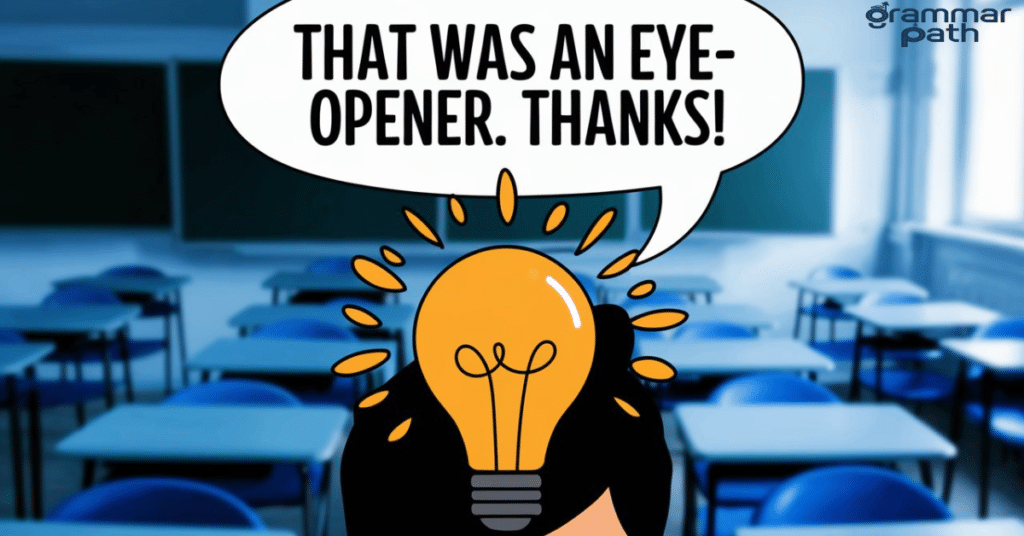
7. “I’m indebted to you for your clear explanation.”
Scenario: A financial advisor clarifies investment strategies.
In-person conversation: “I’m indebted to you for your clear explanation, Ms. Patel. Your insights on diversification strategies have given me a new perspective on my portfolio.”
8. “You’ve made it crystal clear.”
Scenario: A colleague explains a new company policy.
Slack message:
You: You've made it crystal clear, Jake. I now understand exactly how the new leave policy works.
Jake: Glad I could help! Let me know if you have any more questions.
9. “Your clarification was invaluable.”
Scenario: A doctor explains a medical diagnosis.
Email example:
Subject: Follow-up on Recent Diagnosis
Dear Dr. Martinez,
Your clarification was invaluable. I now have a much better grasp of my condition and the treatment options available.
Sincerely,
Robert Johnson
10. “I’m enlightened, thanks to your explanation.”
Scenario: A museum guide explains the significance of an artifact.
In-person conversation: “I’m enlightened, thanks to your explanation. I never realized this ancient pottery had such a fascinating history!”
11. “You’ve cleared up my confusion.”
Scenario: A colleague clarifies a misunderstanding about project responsibilities.
Email example:
Subject: Re: Project Roles Clarification
Hi Tom,
You've cleared up my confusion about the task allocation. I now understand my role in the marketing phase of the project.
Best,
Samantha
12. “Your explanation was a game-changer.”
Scenario: A fitness trainer explains proper form for a complex exercise.
Text message:
You: Your explanation was a game-changer! I finally nailed that kettlebell swing without hurting my back.
Trainer: That's awesome! Proper form makes all the difference. Keep it up!
13. “I’m grateful for your elucidation.”
Scenario: A professor clarifies a complex philosophical concept.
In-person conversation: “Professor Williams, I’m grateful for your elucidation on Kant’s Categorical Imperative. Your real-world examples really helped it click for me.”
14. “You’ve painted a clear picture for me.”
Scenario: An interior designer explains their vision for a room makeover.
Email example:
Subject: Living Room Design Concept
Dear Ms. Chen,
You've painted a clear picture for me of how the living room will look. Your explanation of the color scheme and furniture placement has me excited to see the final result.
Warm regards,
David Thompson
15. “Your insights have been illuminating.”
Scenario: A mentor provides career advice.
LinkedIn message:
You: Your insights have been illuminating, Lisa. I now have a much clearer path for my career development.
Lisa: I'm so glad I could help! Remember, your journey is unique—trust your instincts too.
16. “I appreciate you breaking that down for me.”
Scenario: A mechanic explains a car problem.
In-person conversation: “I appreciate you breaking that down for me, Joe. I had no idea the timing belt was so crucial. You’ve saved me from a potential disaster!”
17. “Your explanation was spot-on.”
Scenario: A colleague clarifies a complex data analysis.
Slack message:
You: Your explanation was spot-on, Raj. The correlation between customer satisfaction and retention makes much more sense now.
Raj: Happy to help! Data can be tricky, but it tells such an important story when you understand it.
18. “Thanks for shedding light on the matter.”
Scenario: A real estate agent explains property zoning laws.
Email example:
Subject: Re: Zoning Laws Clarification
Dear Mr. Johnson,
Thanks for shedding light on the matter of local zoning laws. Your explanation has given me a much better understanding of what we can and can't do with the property.
Best regards,
Emily Carter
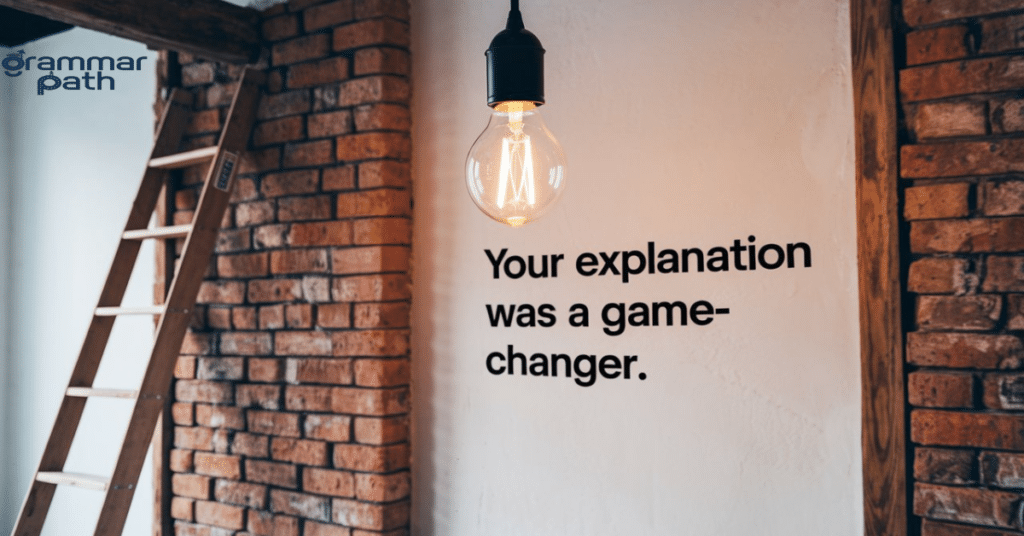
19. “I’m grateful for your clear communication.”
Scenario: A project manager clarifies team objectives.
Team meeting: “Sarah, I’m grateful for your clear communication on our Q4 goals. The roadmap you’ve laid out gives us all a solid direction to work towards.”
20. “Your explanation was a breath of fresh air.”
Scenario: A tech support representative explains a software feature.
Chat support:
You: Your explanation was a breath of fresh air! I've been struggling with this feature for days, and you made it so simple to understand.
Agent: I'm thrilled I could help! Sometimes all it takes is a different perspective. Enjoy using the new feature!
21. “You’ve connected the dots for me.”
Scenario: A marketing strategist explains a complex customer journey.
Email example:
Subject: Re: Customer Journey Mapping
Hi Priya,
You've connected the dots for me on our customer's path from awareness to purchase. Your breakdown of each touchpoint has given me a **comprehensive understanding** of our marketing strategy.
Thanks,
Marcus
22. “Your explanation was like turning on a light bulb.”
Scenario: A coding mentor clarifies a tricky programming concept.
Slack message:
You: Your explanation was like turning on a light bulb! I finally understand how closures work in JavaScript.
Mentor: That's great to hear! Sometimes it just takes the right analogy to make things click.23. “I’m impressed by your ability to simplify complex ideas.”
Scenario: A colleague explains a new company-wide initiative.
In-person conversation:
“Wow, Jake! I’m impressed by your ability to simplify complex ideas. Your breakdown of the new sustainability initiative really helped me grasp its importance and my role in it.”
24. “Your clarification was like a breath of fresh air.”
Scenario: A financial advisor explains investment strategies.
Email example:
Subject: Investment Strategy Clarification
Dear Ms. Rodriguez,
Your clarification was like a breath of fresh air. I now have a clear understanding of how **diversification** can mitigate risks in my portfolio.
Best regards,
Thomas Chen25. “You’ve untangled that knot for me.”
Scenario: HR representative explains a complex benefits package.
Teams chat:
You: You've untangled that knot for me, Sarah. The healthcare options make so much more sense now.
Sarah: Happy to help! Benefits can be confusing, but they're so important to understand.26. “I’m amazed at how you made that so understandable.”
Scenario: A scientist explains a complex environmental process to a group of non-experts.
In-person conversation:
“Dr. Patel, I’m amazed at how you made that so understandable. Your explanation of carbon sequestration was both clear and fascinating!”

27. “Your explanation was worth its weight in gold.”
Scenario: A legal advisor clarifies contract terms.
Email example:
Subject: Re: Contract Clarification
Dear Mr. Thompson,
Your explanation was worth its weight in gold. I now fully grasp the implications of the **non-compete clause** and how it affects our business operations.
Sincerely,
Olivia Martínez28. “You’ve lifted the fog on this issue.”
Scenario: A team leader clarifies project objectives during a meeting.
Zoom chat:
You: Thanks, Lisa. You've lifted the fog on this issue. Our Q4 goals are much clearer now.
Lisa: Glad I could help! Clear objectives are key to our success.
29. “I’m indebted to you for your crystal-clear explanation.”
Scenario: A tech support representative explains a software feature.
Phone conversation:
“I’m indebted to you for your crystal-clear explanation, John. I’ve been struggling with this data migration tool for days, and you’ve made it seem so simple!”
30. “Your clarification has been a game-changer.”
Scenario: A mentor provides career advice.
LinkedIn message:
You: Your clarification has been a game-changer, Michael. I now have a clear roadmap for transitioning into the tech industry.
Michael: I'm thrilled to hear that! Sometimes all it takes is a fresh perspective to see the path forward.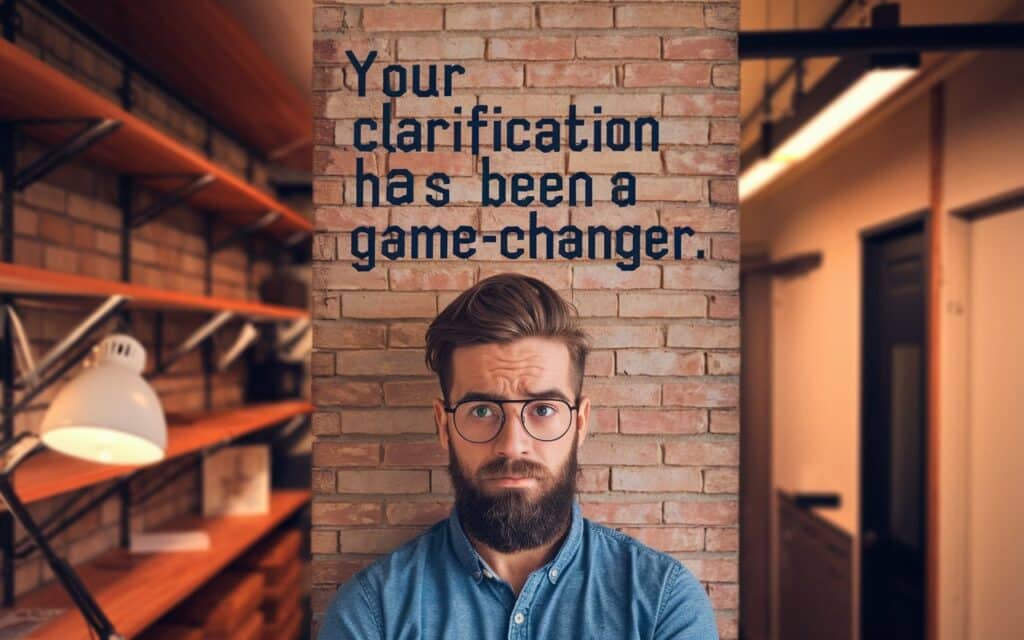
The Art of Choosing the Right Expression
Selecting the perfect way to express gratitude is like choosing the right spice for a dish—it can elevate the entire experience. The key lies in reading the room and gauging the relationship you have with the person you’re thanking.
In formal settings, phrases like “Thank you for clarifying” or “I’m grateful for your elucidation” can add a touch of professionalism and respect. These expressions not only convey thanks but also acknowledge the expertise of the person who provided the explanation.
For more casual interactions, phrases like “That was an eye-opener. Thanks!” or “You’ve cleared up my confusion” strike a friendly, approachable tone. They’re perfect for colleagues you’re comfortable with or in less formal work environments.
Remember, the goal is to sound authentic and sincere. Choose phrases that feel natural coming from you. If you’re not comfortable with more elaborate expressions, a simple “Thank you for clarifying” or a heartfelt “I really appreciate your clear explanation” can be just as effective.
The Impact of Gratitude in Professional Settings
In the professional world, expressing gratitude for clarification isn’t just polite—it’s smart business. It fosters a culture of open communication, encourages knowledge sharing, and builds stronger professional relationships.
When you thank someone for clarifying something, you’re doing more than acknowledging their help. You’re:
- Encouraging future assistance: People are more likely to help again if they feel their efforts are appreciated.
- Building rapport: Gratitude creates positive associations, making future interactions smoother.
- Demonstrating professionalism: It shows you value clear communication and others’ expertise.
- Creating a positive work environment: Gratitude is contagious and can improve overall team morale.
Pro Tip: The most impactful paragraph in this article is the one explaining the power of gratitude. It sets the foundation for why these alternative expressions matter, highlighting how thoughtful appreciation can transform professional relationships and workplace dynamics.
Adapting Your Thanks to Different Scenarios
Different situations call for different levels of formality and detail in your expressions of gratitude. Let’s break it down:
Email Communications
In emails, you have the luxury of crafting a more detailed response. You can explain specifically what part of the clarification was helpful. For example:
Subject: Re: Project Timeline Query
Dear Alex,
Thank you for elucidating the project timeline. Your breakdown of each phase, especially the testing period, has given me a much clearer picture of our roadmap. This will significantly help in allocating resources more efficiently.
Best regards,
Emma
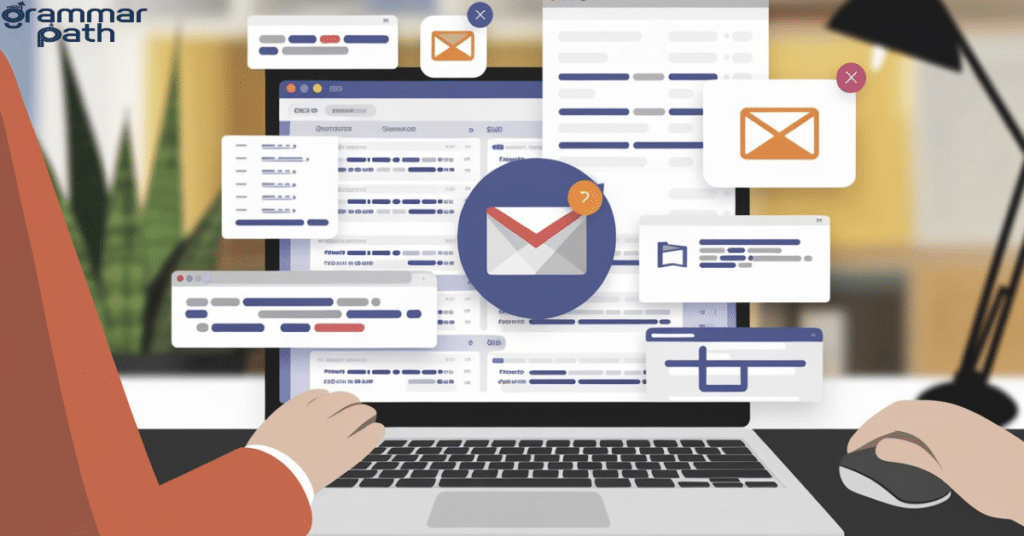
In-Person Conversations
Face-to-face, your body language and tone play a crucial role. A smile and enthusiastic tone can amplify a simple “That really cleared things up for me, thanks!”
Quick Digital Exchanges (Slack, Text)
For rapid communications, keep it brief but warm. “You’ve painted a clear picture for me. Thanks a bunch!” works well in these contexts.
Formal Presentations or Meetings
In more formal settings, it’s important to acknowledge the value of the clarification: “Thank you for clarifying. I appreciate your insight on this matter. Your explanation has significantly enhanced our understanding of the project scope.”
Remember, the key is to match your tone to the context while still conveying sincere appreciation.
Cultivating a Habit of Expressive Gratitude
Developing a rich vocabulary for expressing thanks isn’t just about memorizing phrases—it’s about cultivating a mindset of appreciation. Here are some tips to help you make expressive gratitude a natural part of your communication:
- Practice active listening: Really tune in when someone’s explaining something. This will help you pinpoint exactly what to thank them for.
- Reflect on the value: Before responding, take a moment to consider how the clarification has helped you. This will make your thanks more specific and heartfelt.
- Keep a gratitude journal: Jot down instances where someone’s explanation was particularly helpful. This practice can make you more attuned to opportunities for expressing thanks.
- Expand your vocabulary: Regularly learning new words and phrases can help you express gratitude more creatively.
- Observe others: Pay attention to how colleagues and mentors express thanks. You might pick up some new, natural-sounding phrases.
By making these practices a habit, you’ll find yourself naturally reaching for more expressive ways to say “thank you for clarifying” in no time.
The Ripple Effect of Thoughtful Appreciation
When you take the time to express gratitude in a thoughtful, varied way, you’re not just being polite—you’re creating a positive ripple effect in your professional and personal spheres.
Consider this: When you respond to a clarification with a unique, heartfelt expression of thanks, you’re:
- Boosting morale: The person who helped you feels valued and appreciated.
- Setting an example: Others observe and may adopt similar practices, improving overall communication.
- Building your reputation: You become known as someone who values clear communication and shows appreciation.
- Strengthening relationships: Genuine gratitude fosters stronger, more positive connections.
- Encouraging knowledge sharing: People are more likely to offer explanations and help in the future.
By mastering the art of expressing gratitude for clarification, you’re not just enhancing your own communication skills—you’re contributing to a more positive, collaborative environment for everyone around you.
Certainly! Here are 10 more creative ways to express your appreciation for clarification, following the same style and formatting as before:
Pro Tip: The most impactful aspect of this expanded section is how it illustrates the ripple effect of thoughtful gratitude. By showing how individual expressions of thanks can transform entire work cultures, it motivates readers to put these phrases into practice, creating positive change in their professional environments.
The Nuances of Gratitude: Choosing the Right Expression
As we expand our repertoire of gratitude expressions, it’s crucial to understand the nuances that make each phrase unique. The art lies not just in having a variety of phrases at your disposal, but in choosing the right one for each situation.
Consider the level of impact the clarification had on your understanding. Was it a minor point that needed clearing up, or did it fundamentally change your perspective? Phrases like “You’ve connected the dots for me” or “Your clarification has been a game-changer” convey a significant impact, while “You’ve lifted the fog on this issue” might be more appropriate for a moderate clarification.
Also, think about the effort the person put into their explanation. If someone went above and beyond to break down a complex topic, acknowledging that with “I’m impressed by your ability to simplify complex ideas” shows that you recognize and appreciate their skill.
The relationship you have with the person providing clarification also plays a role. More casual expressions like “Your explanation was like turning on a light bulb” might be perfect for a peer or a mentor you have a good rapport with, while “I’m indebted to you for your crystal-clear explanation” could be more suitable in formal or hierarchical relationships.
Remember, the goal is to match the warmth and specificity of your gratitude to the situation. This thoughtful approach not only expresses your thanks but also strengthens your professional relationships and communication skills.
Cultivating a Culture of Clarity and Appreciation
By expanding your vocabulary of gratitude, you’re not just improving your own communication—you’re contributing to a culture of clarity and appreciation in your professional environment. Here’s how:
- Encouraging clear communication: When people know their efforts to explain clearly are appreciated, they’re more likely to continue doing so.
- Fostering a learning environment: Expressing specific gratitude for clarifications creates an atmosphere where asking questions and seeking understanding is valued.
- Building stronger teams: Regular, genuine appreciation strengthens bonds between team members and improves overall collaboration.
- Enhancing emotional intelligence: Practicing varied expressions of gratitude helps develop your ability to read situations and respond appropriately.
- Improving problem-solving: A culture where clarification is appreciated leads to more open discussions and, ultimately, better solutions to complex problems.
Conclusion
As we wrap up our exploration of alternative ways to say “thank you for clarifying,” remember that the power of gratitude lies in its sincerity and specificity. Each of the 30 expressions we’ve discussed offers a unique way to acknowledge someone’s effort in providing clarity.
Whether you’re in a formal business setting, a casual conversation with a friend, or anywhere in between, having a diverse repertoire of gratitude expressions allows you to respond appropriately and meaningfully. It’s not just about politeness—it’s about building stronger connections, fostering a culture of clear communication, and showing genuine appreciation for the knowledge others share.
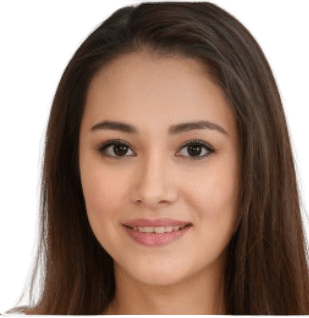
Emily Olivia is an experienced writer specializing in grammar and English language topics. With a passion for clarity and precision, she shares valuable insights on synonyms, grammar rules, and writing tips to help readers enhance their language skills on Grammar Path.

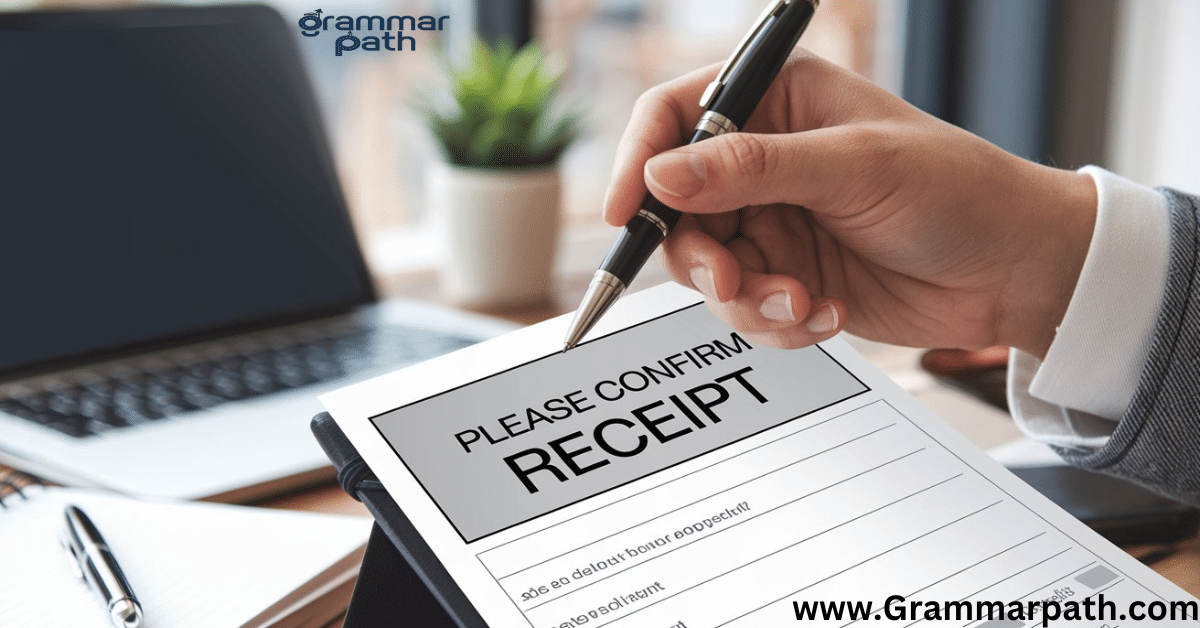
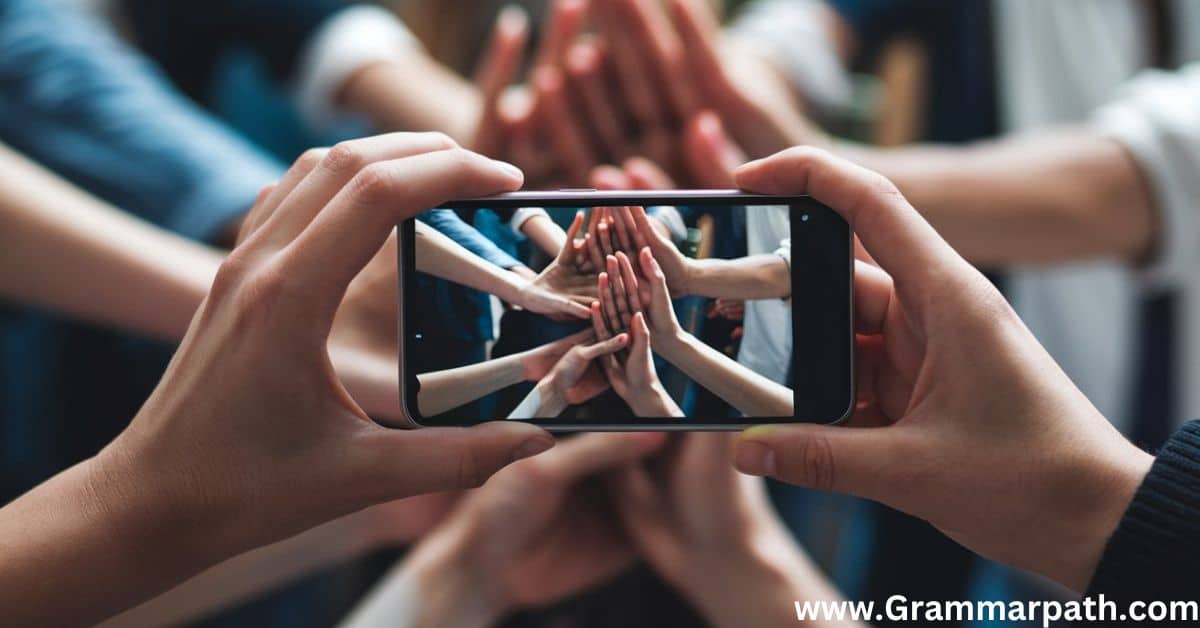



2 Comments
its very informational